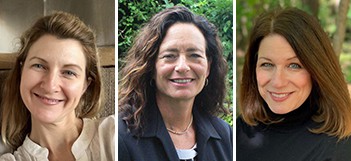
By John Bradley
“How many people participating today would like to mitigate flooding, improve water quality in our rivers and streams and Long Island Sound and create a healthier home environment?” asked Nancy Seligson at the opening of the Larchmont-Mamaroneck Local Summit program, “Sustainable Landscaping: A Beautiful Approach for a Healthy Yard and a Healthy Planet,” held via Zoom on Tuesday morning, March 8th.
Seligson, the Supervisor of the Town of Mamaroneck for the decade between Hurricane Sandy in 2011 and Hurricane Ida at the close of 2021, was joined by June Wallach, Co-Chair of the Town of Mamaroneck Sustainability Collaborative and Lisa McDonald, Co-Chair of the Village of Larchmont Environmental Committee.
Yards Can Be Beautiful without the Use of Pesticides
“We love our lawns,” Seligson declared, “but if you want a truly healthy yard, she advised, “Don’t use or allow gas-powered leaf blowers in your yard. Mulch-mow your leaves rather than removing them from your yard.” And, “Don’t use pesticides and chemical fertilizers—use organic products in limited amounts to reduce (toxic) runoff.” Summing up, Seligson showed a photo of her own attractive yard, noting “I am proud to say that I haven’t used fertilizers, pesticides, or leaf blowers for over twenty years.”
According to June Wallach, “You need not sacrifice curb appeal to have a beautiful lawn.” Noting that often the traditional approach to yard care involves methods that serve neither plants nor the environment well, she cautioned that the use of pesticides and herbicides might also be dangerous to the those who use them. A photograph depicting a small, barefoot child on a patch of lawn with a yellow pesticide warning in the foreground, and the same photo with a “Healthy Yard” (pesticide-free) sign in the foreground was offered to make the point. The caption: “Why Risk It?”
Wallach said that since the establishment of the Larchmont/Mamaroneck “Healthy Yards” program, hundreds of residents have taken the healthy yards pledge, promising not to use pesticides or herbicides on their lawns. “This is an idea that is gaining in acceptance,” she said, adding that the “NYS Department of Environmental Conservation says that safe and effective alternatives already exist for most chemical pesticides and fertilizers.”
Lisa McDonald joined her co-panelists, stating that “We need to change our perceptions of what a beautiful yard is. Is it one that supports life, including our own? Or are we damaging our own health, our workers’ health, our environment, and our
properties to achieve this fleeting, sterile aesthetic?”
Why the Concern Over Leaf-Blowers
Perhaps the most obvious reason for concern over leaf-blowers is the noise they generate. McDonald explained that the noise from gasoline-powered leaf blowers is decibels higher than the CDC limit for adverse effects and over time can damage hearing. She shared that studies have shown that “environmental noise has become the new second-hand smoke linked to heart disease, hypertension and immune system suppression,” resulting in a number of health organizations – including the World Health Organization, the EPA, and the CDC – speaking up against the noise produced by gas-powered leaf blowers.
Beyond the noise pollution, McDonald cautioned that there are other very serious effects stemming from the use of gas-powered leaf blowers. She shared they “produce more harmful greenhouse gas emissions than large cars.” In fact, she noted that “the pollution from just one hour of gas-powered leaf blower use is equivalent to driving 1100 miles in an average car” and that “they also produce large amounts of carbon monoxide and ozone-forming chemicals that contribute to smog and are highly toxic to our lungs.”
Furthermore, McDonald says that leaf blowers are particularly damaging to yard care crews because they work in close proximity to the noise, exhaust and air-borne debris all day. Without the leaf blower ban, “We are asking crews to sacrifice their long-term health to perform an unnecessary service for which there are safer tools and equipment.”
Community Response
What are communities doing in response to the overwhelming evidence about the damaging effects of leaf blowers? According to McDonald, a growing number of communities nation-wide are restricting the use of gas-powered leaf blowers and other lawn equipment. The Village of Larchmont has outlawed gas-powered leaf blowers entirely, and electric blowers can only be used for spring and fall cleanups for the month of April and from October 15th to December 15th. The Town of Mamaroneck has banned the use of gas-powered leaf blowers from June 1 to September 30. The Village of Mamaroneck has a ban on all blowers (gas and electric) from May 15 to September 30.
Resources: In closing, the panelists provided links to learn more about healthy, sustainable yard care practices:
Websites:
Larchmont-Mamaroneck Healthy Yards Program: www.lmhealthyyards.org/
Village of Larchmont: villageoflarchmont.org/sustainable-leaf-maintenance/
Larchmont Pollinator Pathways larchmont-mamaroneckpollinatorpathway.org
Long Island Sound Study: Sound Gardening: https://longislandsoundstudy.net/get-involved/what-you-can-do/around-your-backyard/sound-gardening/
Questions?
Email: Town of Mamaroneck: sodierna@townofmamaroneckny.org
Village of Larchmont: volenvironmentalcommittee@gmail.com





